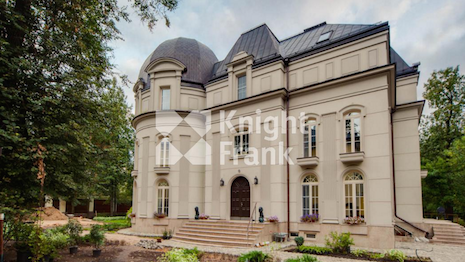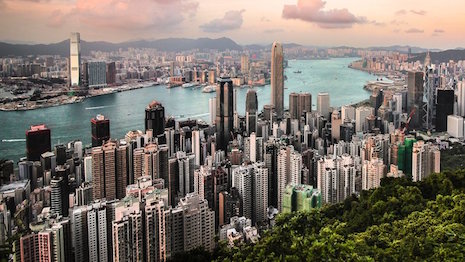
Luxury apartment listing in Seoul; Image credit: Seoul Homes.
By Mickey Alam Khan
Prime real estate in urban areas around the globe rose by 4.8 percent in the first quarter, but Seoul dramatically jumped ahead at 25 percent thanks to Gangnam's disregard for price growth control policies.
According to Knight Frank’s Prime Global Cities Index for Q1 2018, New York prices have only grown 1 percent in the last year until March, but this could change soon. Stockholm, Taipei and St Petersburg saw the steepest declines this past year at 8.4 percent, 7.4 percent and 4 percent, respectively.
“Key European cities are well-represented at the top of the table," said Kate Everett-Allen, international residential research at Knight Frank. "Edinburgh and Zurich join Berlin, Paris and Madrid in the top 15 this quarter."
Real estate insight
Moscow is no longer the weakest-performing prime market, thanks to Stockholm, Taipei and St Petersburg.
 Knight Frank Moscow rental; Image credit: Knight Frank
Knight Frank Moscow rental; Image credit: Knight Frank
In New York, Growth in Wall Street pay and the weakened U.S. dollar could support a bounce-back in prime market price growth, even from non-domestic buyers.
While the index as a whole grew 4.8 percent, this is a decline compared to 4.9 percent in December.
Seoul may have been at the top of the index for growth rate, but Cape Town, South Africa was close behind with prices at 19.3 percent higher throughout the year. Limited inventory is driving prices in the prime markets of Cape Town, but the city as a whole is cooling.
Hong Kong prices are growing as well at 6.9 percent at the prime level, but mainstream prices are doing even better.
London, Hong Kong and New York remain the world’s top tier for prime market cities, each with increases compared to last year’s fourth quarter. Brexit and other political happenings in London have left the city uncertain, but Knight Frank states that stability is being restored.
 Hong Kong boasts some of the most wealthy consumers in Asia Pacific and also some of the most expensive real estate. Image credit: Florian Wehde via Luxury Society
Hong Kong boasts some of the most wealthy consumers in Asia Pacific and also some of the most expensive real estate. Image credit: Florian Wehde via Luxury Society
Prices for prime country houses in the U.K. rose by almost half a percent in the first quarter of 2018, reversing a drop that occurred at the end of last year, according to a previous report from Knight Frank.
The overall market for country houses in the U.K. is being affected by supply and demand issues, Knight Frank says. Much of this can be attributed to uncertainty over Brexit, which has made estimating the supply of luxury houses in the British country difficult (
see more).
Asia-Pacific cities now make five out of the top cities within Knight Frank’s Prime Global Cities Index.
Edinburg, Scotland has cracked the top 15 this year, along with Zurich, for the first time, with a year-over-year growth of 7.7 percent. Sales above 500,000 euros, or $593,500 at current exchange, grew by 17 percent.
Additional insight
Switzerland is becoming an asylum for wealthy consumers looking for not just financial security, but personal safety as well.
According to a report from real estate brokerage Knight Frank, over the last five years, the affluent have been flocking to Switzerland more so than before as their interests now stem beyond tax relief. Privacy, safety and education are now driving factors that are drawing in many consumers from overseas (
see more).
“The index increased by 4.8 percent in the year to March 2018, marginally lower than the 4.9 percent in December 2017,” Ms. Everett-Allen said. “As borrowing costs start to increase across some of the world’s major economies we expect prime price growth to moderate further.
“Already, the gap between the strongest and weakest-performing city has slipped from 39 percent to 33 percent in the last three months and the number of cities that saw their rate of annual growth decline has risen from 16 to 23 over the same three-month period,” she said. “Seoul has overtaken Guangzhou this quarter, registering 24.7 percent annual growth.
“Across a large part of the city new macro prudential measures, including new taxes for owners of multiple properties and tighter lending restrictions, are cooling growth, but the prime area of Gangnam is still seeing strong speculative activity.”
 Luxury apartment listing in Seoul; Image credit: Seoul Homes.
Luxury apartment listing in Seoul; Image credit: Seoul Homes.
 Knight Frank Moscow rental; Image credit: Knight Frank
Knight Frank Moscow rental; Image credit: Knight Frank Hong Kong boasts some of the most wealthy consumers in Asia Pacific and also some of the most expensive real estate. Image credit: Florian Wehde via Luxury Society
Hong Kong boasts some of the most wealthy consumers in Asia Pacific and also some of the most expensive real estate. Image credit: Florian Wehde via Luxury Society